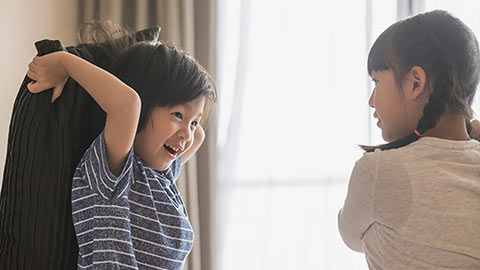
You’ve just arrived home from the hospital, after giving birth. There’s a grand celebration of your homecoming with friends and family attending – virtually via Zoom, for the time being. As you are showing everyone the newest addition to the family, your husband gently holds you in his arms and your oldest coos at the little one over your shoulder. However, amidst all the expressions of delight and the sounds of wonder, you spot your middle child turned away from the rest of the scene. Possibly skulking away, purposely ignoring everyone. Or simply blasé about this new turn of events. Ever been in a situation like this before? Here are the ways you can address the second child syndrome.
First: The Definition
The middle child syndrome is defined as a psychological condition. This condition is found among children who are born in between other children1. They say that the order of birth can affect the personality of the child2. In most cases, there’s the more confident eldest child or the firstborn, the baby of the family or the latest addition to the family, and then, there’s the middle child who is neither the eldest or the youngest.
Second child syndrome occurs when the middle child has confidence and self-esteem issues, combined with feelings of jealousy and inadequacy1. This is often attributed to the fact that they feel left out in the family since the oldest gets to do everything first, while everyone babies the youngest2. Indeed, your children will have different personalities depending on their birth order and how you treat them because of such3. The question of fitting in and finding his or her place in the family, is first and foremost, on the mind of the second child2.
While common, not all middle children develop the second child syndrome because of proper parenting skills1. Some middle-born children become independent and accommodating because they have learned to compromise2. Parents who immediately spot behavioral changes and are able to respond to each of their children, can prevent this syndrome from happening1. The child’s attitude might also have a considerable bearing on whether there will be second child syndrome. This is especially so when they are able to deal with changes easily than other second borns1.
In their own right, middle children can be excellent mediators, learning to deal with being in the middle1. Other times, because parents are too focused on the eldest or the youngest, the second child often gets away with things. Thus, this makes them more of a risk taker than their other siblings1. Stuck in the middle, they are also easily adaptable and open to changes1.
Second: The Symptoms
Parents are often more at ease about child-rearing once the second child arrives3. As a result, most children who suffer from the second child syndrome experience low esteem. This is because they feel left out and unloved by their parents1. Because of this as well, they may distance and isolate themselves from others. The choice to do so comes from fear that they will also be excluded and unloved by others1. However, once they overcome this fear, middle-born children prefer more relationships outside the familial circle2. They tend to make more friends. They also have larger social circles outside the home, since they receive little attention at home3.
Other symptoms include feeling unworthy or not valued at home3. Since they feel that they do not deserve love and attention, the second child goes on blaming themselves and this feeds the feelings of unworthiness1. Because the parents’ attention is divided among three or more children, the middle child often feels frustrated of not receiving such attention. He/she would resort to attention-seeking behavior such as tantrums and hissy-fits1. Those suffering from second child syndrome are also likely to act out and rebel, in contrast to the behavior of their other siblings2. Consequently, they view their siblings as competitors for their parents’ love and attention. And this breeds envy, resulting in bitter rivalry1.
As an adult, some may still bear the markings of second child syndrome. Some do not like being told what to do, while others can have codependency issues2. However, other middle children may become good at negotiating and mediating later in life2.
Third: The Prevention
Essentially, second child syndrome refers to behavioral changes in your child. This is brought on by changes in parenting style4. For the most part, being attuned to your children and knowing the signs will prevent the development of second child syndrome1. In case your second child begins exhibiting the symptoms, take a deep breath. Be patient with him or her1. These things, after all, take time and extra attention.
Make your second born feel special by connecting with him or her more. Hear out what he or she has to say, and generally, just make your child feel important1. If there’s a hobby or sport that your middle child is particularly good at, encourage and motivate them. This gives them an extra boost of confidence and self-esteem that will curb the onset of second child syndrome1. It is also best if you avoid comparing your children. This is because each child has their own personality, strengths, and weaknesses1. Tell your children to love each other. Help them to play and work together so that they will understand each other better4.
And possibly, the best advice would be to limit – or entirely, get rid of – the hand-me-downs2. Most second born children settle for the hand-me-downs from their older brother or sister and often get mistaken for the older siblings. This is because of clothes previously worn by the older sibling5.
Finally, teach your middle child that you as mother and parent must be shared with his or her other siblings4. Communicate with your second born that you cannot be monopolized and his or her siblings might also need you4. Nevertheless, the fact remains that you love all of them equally.
Be part of Club Mama today to unlock a world of privileges and benefits which include free samples, exclusive vouchers, promotions, expert advice and many more!
References:
1 Middle Child Syndrome – Signs and Tips to Prevent It (2019) Retrieved October 2, 2020 from https://parenting.firstcry.com/articles/middle-child-syndrome-signs-and… 372709
2 Middle Child Syndrome: Everything You Need to Know (2015) Retrieved October 2, 2020 from https://www.parents.com/parenting/better-parenting/style/10-tips-for-pa…
3 Birth Order Traits: Your Guide to Sibling Personality Differences (2020) Retrieved October 2, 2020 from https://www.parents.com/baby/development/social/birth-order-and-persona…
4 Second Child Syndrome: Everything You Want to Know (2013) Retrieved October 2, 2020 from https://www.beingtheparent.com/second-child-syndrome/
5 How to spot a second child (2013) Retrieved October 2, 2020 from https://www.kidspot.com.au/parenting/parenthood/siblings/how-to-spot-a-…;


